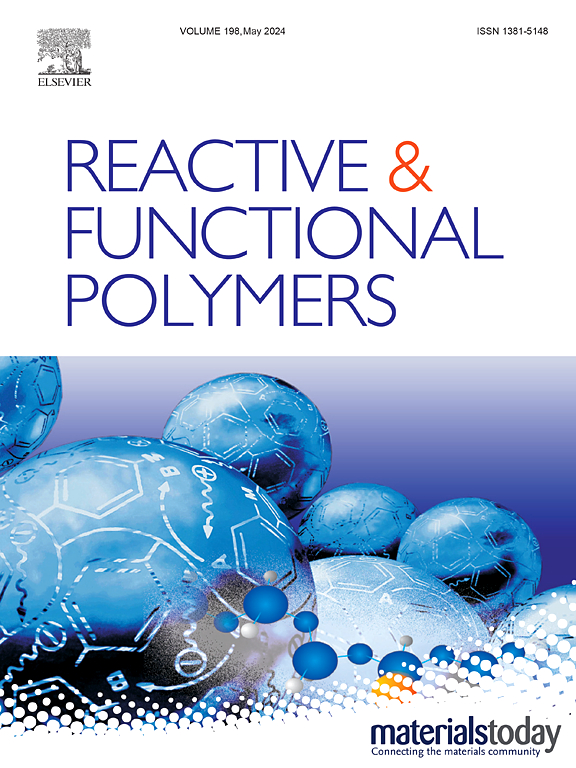用于防伪和白光二极管的碳化聚合物点基室温磷光复合材料
IF 5.1
3区 工程技术
Q1 CHEMISTRY, APPLIED
引用次数: 0
摘要
碳化聚合物点(CPDs)由于其低廉的成本、良好的生物相容性和交联增强的发射效应,在室温磷光(RTP)中得到了广泛的研究。虽然近年来取得了相当大的成就,但编制长期的RTP CPDs仍然是一项艰巨的任务。本文将Arg-CPDs引入刚性硼酸(BA)基体中,以提高Arg-CPDs@BA复合材料的RTP寿命。富氮精氨酸框架与磷掺杂增强了自旋轨道耦合,加速了系统间的交叉,促进了三重态激子的产生。arg - cpd与刚性B2O3基体之间形成的CB共价键限制了cpd的振动和旋转,从而抑制了三重态激子的非辐射跃迁,使复合材料的RTP发射寿命相对较长,为983 ms(肉眼为18 s)。它比无基质的Arg-CPDs长近7倍。并对其在防伪、白光二极管等方面的应用前景进行了展望。本文章由计算机程序翻译,如有差异,请以英文原文为准。

Carbonized polymer dots-based room temperature phosphorescence composites for anti-counterfeiting and white light-emitting diodes
Carbonized polymer dots (CPDs) have been studied extensively for room temperature phosphorescence (RTP) due to their low cost, good biocompatibility and crosslink-enhanced emission effect. Although considerable achievements have been reached in recent years, it is still a formidable task to prepare long-lived RTP CPDs. Herein, the Arg-CPDs was introduced into a rigid boric acid (BA) matrix to enhance the RTP lifetime of the Arg-CPDs@BA composites. The nitrogen-rich arginine framework integrated with phosphorus doping enhances spin-orbit coupling and accelerates the intersystem crossing and promotes the generation of triplet excitons. The formed C![]() B covalent bond between Arg-CPDs and rigid B2O3 matrix restricts the vibration and rotation of CPDs, thus inhibiting the non-radiative transition of the triplet excitons and making the composite exhibit a relatively long-lived RTP emission of 983 ms (18 s for naked eyes). It was nearly seven times longer than that of the matrix-free Arg-CPDs. Besides, the potential applications in anti-counterfeiting and white light-emitting diodes were demonstrated.
B covalent bond between Arg-CPDs and rigid B2O3 matrix restricts the vibration and rotation of CPDs, thus inhibiting the non-radiative transition of the triplet excitons and making the composite exhibit a relatively long-lived RTP emission of 983 ms (18 s for naked eyes). It was nearly seven times longer than that of the matrix-free Arg-CPDs. Besides, the potential applications in anti-counterfeiting and white light-emitting diodes were demonstrated.
求助全文
通过发布文献求助,成功后即可免费获取论文全文。
去求助
来源期刊

Reactive & Functional Polymers
工程技术-高分子科学
CiteScore
8.90
自引率
5.90%
发文量
259
审稿时长
27 days
期刊介绍:
Reactive & Functional Polymers provides a forum to disseminate original ideas, concepts and developments in the science and technology of polymers with functional groups, which impart specific chemical reactivity or physical, chemical, structural, biological, and pharmacological functionality. The scope covers organic polymers, acting for instance as reagents, catalysts, templates, ion-exchangers, selective sorbents, chelating or antimicrobial agents, drug carriers, sensors, membranes, and hydrogels. This also includes reactive cross-linkable prepolymers and high-performance thermosetting polymers, natural or degradable polymers, conducting polymers, and porous polymers.
Original research articles must contain thorough molecular and material characterization data on synthesis of the above polymers in combination with their applications. Applications include but are not limited to catalysis, water or effluent treatment, separations and recovery, electronics and information storage, energy conversion, encapsulation, or adhesion.
 求助内容:
求助内容: 应助结果提醒方式:
应助结果提醒方式:


